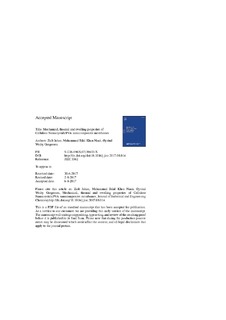| dc.contributor.author | Jahan, Zaib | |
| dc.contributor.author | Niazi, Muhammad Bilal Khan | |
| dc.contributor.author | Gregersen, Øyvind Weiby | |
| dc.date.accessioned | 2019-03-11T10:03:46Z | |
| dc.date.available | 2019-03-11T10:03:46Z | |
| dc.date.created | 2018-11-25T12:02:16Z | |
| dc.date.issued | 2018 | |
| dc.identifier.citation | Journal of Industrial and Engineering Chemistry. 2018, 57 113-124. | nb_NO |
| dc.identifier.issn | 1226-086X | |
| dc.identifier.uri | http://hdl.handle.net/11250/2589535 | |
| dc.description.abstract | Cellulose nanocrystals (CNC) have strong reinforcing properties when incorporated in a compatible polymer matrix. The study was conducted to investigate the effect of addition of different proportions of CNC on the mechanical, thermal and swelling properties of poly(vinyl alcohol) (PVA) nanocomposite membranes for biogas separation. The incorporation of CNC in PVA increased the crystallinity at all investigated relative humidities. No apparent trend is observed for mechanical properties for dry membranes (0% RH) with addition of CNC in PVA matrix. However, at 93% RH the elastic modulus increased 25 times with addition of CNC compared to pure PVA membranes. Moreover, tensile strength also showed twice the values at 53% RH and 93% RH after the addition of CNC. Membranes containing higher CNC content absorbed 9% less moisture. Swelling, thermal and mechanical properties indicate a good potential of CNC/PVA nanocomposite membranes for use in CO2 separation membranes. | nb_NO |
| dc.language.iso | eng | nb_NO |
| dc.publisher | Elsevier | nb_NO |
| dc.relation.uri | https://www.sciencedirect.com/science/article/pii/S1226086X1730432X?via%3Dihub | |
| dc.rights | Attribution-NonCommercial-NoDerivatives 4.0 Internasjonal | * |
| dc.rights.uri | http://creativecommons.org/licenses/by-nc-nd/4.0/deed.no | * |
| dc.title | Mechanical, thermal and swelling properties of cellulose nanocrystals/PVA nanocomposites membranes | nb_NO |
| dc.type | Journal article | nb_NO |
| dc.type | Peer reviewed | nb_NO |
| dc.description.version | acceptedVersion | nb_NO |
| dc.source.pagenumber | 113-124 | nb_NO |
| dc.source.volume | 57 | nb_NO |
| dc.source.journal | Journal of Industrial and Engineering Chemistry | nb_NO |
| dc.identifier.doi | 10.1016/j.jiec.2017.08.014 | |
| dc.identifier.cristin | 1634625 | |
| dc.relation.project | Norges forskningsråd: 239172 | nb_NO |
| dc.description.localcode | © 2017 The Korean Society of Industrial and Engineering Chemistry. Published by Elsevier B.V. This is the authors’ accepted and refereed manuscript to the article. Locked until 13 August 2019 due to copyright restrictions. This manuscript version is made available under the CC-BY-NC-ND 4.0 license http://creativecommons.org/licenses/by-nc-nd/4.0/ | nb_NO |
| cristin.unitcode | 194,66,30,0 | |
| cristin.unitcode | 194,66,1,0 | |
| cristin.unitname | Institutt for kjemisk prosessteknologi | |
| cristin.unitname | NV fakultetsadministrasjon | |
| cristin.ispublished | true | |
| cristin.fulltext | postprint | |
| cristin.qualitycode | 1 | |

